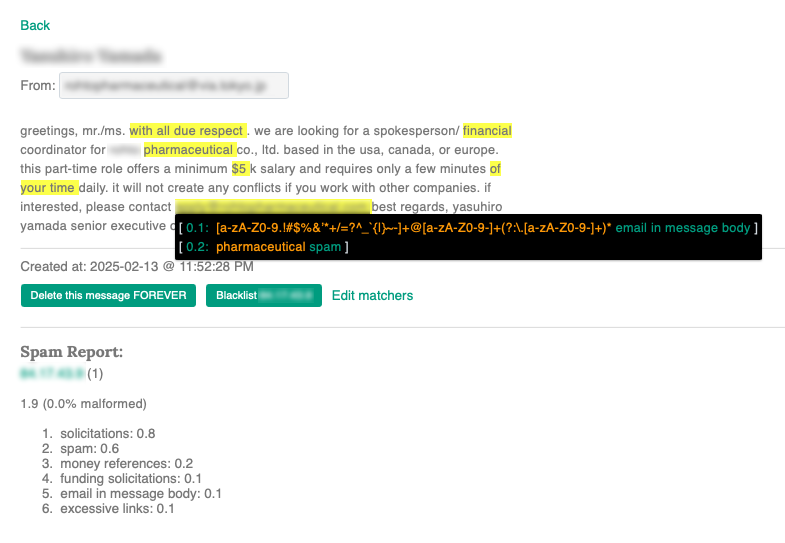How I handle spam
One frustrating aspect of running a public-facing contact form is dealing with spam. Especially in the age of LLMs. Bots are more prevalent now than ever. Over the years, my approach to fighting spam has become more sophisticated. Additionally, I don't want to miss important messages which might result in legitimate business prospects, so my primary goal is to allow humans through and block everything else.
These are the different layers I've implemented:
IP-based blocklist and User-agent analysis
In the early days, I'd see spam and block the corresponding IP address. This was not effective. Spammers typically use blocks of IPs, and there's no guarantee that an IP will remain the same for a single visitor. Spammers typically rotate IPs to bypass naïve IP-based blocklists.
The next obvious step is to look at the request's User-Agent. If it doesn't come from a popular browser, we can easily categorize the message as spam. Although, this doesn't work very well in practice since most spammers are aware of that and specifically craft a request to not be detected as a bot.
Hidden inputs and validations
An early stop-gap is to add an input that won't display to a user, but a bot would automatically fill it out. If the request includes the field, we can categorize it as spam. This keeps out lazy bots, but more sophisticated ones will be able to detect this and skip it.
Additionally, if the message is really short, or really long we can reject the input. This is simple to do with ActiveRecord::Validations
:
class Message < ApplicationRecord
validates :email,
presence: true,
format: { with: URI::MailTo::EMAIL_REGEXP },
length: { minimum: 6, maximum: 254 }
validates :name,
presence: true,
length: { maximum: 100 },
format: { without: %r{[\d\#!/:]}i, message: "cannot contain numbers or punctuation" }
validates :text, presence: true, length: { minimum: 25, maximum: 5000 }
validate :email_is_not_noreply
validate :email_is_not_blacklisted, unless: :captcha_validated?
validate :ip_is_not_blacklisted, unless: :captcha_validated?
validate :name_is_less_than_3_words
validate :is_not_spam, unless: :captcha_validated?
validate :does_not_contain_html
validate :language_is_allowed, unless: :captcha_validated?
validate :text_must_be_more_than_4_words, unless: :captcha_validated?
validate :crc32_is_unique
validate :email_has_mx_record
validate :country_is_allowed
# ...
end
Regex based matchers with a scoring system
The next step was to analyze the content of the messages. Spammers mentioned things like SEO optimization
, and Cryptocurrency
, among other things not related to my website. I developed a system for matching these keywords and phrases via regular expressions and stored them in the database along with a category and score. Using a system that used custom column types to serialize and cast Regex objects with ActiveModel::Type::Value
similar to my post on Native encrypted attributes for Rails ActiveModel.
# app/lib/regex_type.rb
class RegexType < ActiveModel::Type::Value
def cast(value)
value = value.source if value.is_a?(Regexp)
Regexp.new(value, Regexp::IGNORECASE) if value
end
def serialize(value)
value.source rescue value
end
end
# app/models/spam_matcher.rb
class SpamMatcher < ApplicationRecord
# regex : string
# score : decimal
# spam_category : belongs_to
# hidden : boolean
# match_count : integer
belongs_to :spam_category
attribute :regex, RegexType.new
end
The matchers can be used along with ruby's StringScanner class to compile a final score. Anything over 1.0 is considered spam.
This approach was chosen for manual control tuned to my use case versus something like Bayesian classification based on N-Grams.
For a while this worked great. I'd get some spam, manually tweak the matchers and never get that kind of spam again.

Eventually, I noticed spammers getting creative with Unicode characters, which led to the next iteration.
Language detection and Transliteration
The regex approach isn't bullet proof. Spammers are crafty, and can bypass strict character matching in regex patterns. In the age of UTF-8, text-art has come a long way. Take the upside down text generator for example: ˙ɐᴉlɐɹʇsn∀ ɯoɹɟ sᴉ ǝƃɐssǝɯ sᴉɥ┴
, or 1337Speak. The process of normalizing substitute characters like this called transliteration. As it turns out, ActiveSupport::Inflector
includes a transliterate
method that integrates nicely with i18n in Rails.
The process became:
- Use the CLD gem to detect the language
- Transliterate common spam character substitutions
- Apply regex based spam score.
Here's a small list of the transliterations I've seen in spam messages:
en:
i18n:
transliterate:
rule:
Α: "A"
а: "a"
α: "a"
Β: "B"
в: "B"
β: "b"
с: "c"
С: "C"
Ε: "E"
ε: "e"
е: "e"
Е: "E"
Ζ: "Z"
ζ: "z"
η: "n"
Η: "H"
н: "h"
Н: "H"
і: "i"
Ι: "I"
Κ: "K"
к: "k"
Μ: "M"
м: "m"
М: "M"
Ν: "N"
ν: "v"
о: "o"
О: "O"
ρ: "p"
Р: "P"
ς: "s"
С: "C"
ѕ: "s"
т: "t"
Т: "T"
υ: "y"
Υ: "Y"
х: "x"
Х: "X"
у: "y"
У: "Y"
’: "'"
ǃ: "!"
Request origin analysis (geo-ip)
Using a free API, we can further limit messages based on information about the IP address. We can deny messages from countries that we don't do business with, or ASNs that are cloud platforms which bots are typically hosted on.
class GeoIP
def self.cache
@cache ||= ActiveSupport::Cache::MemoryStore.new
end
def self.api_key
Rails.application.credentials.ipinfo_key
end
def self.info(ip)
cache.fetch("GeoIP_#{ip}", expires_in: 12.hours) do
HTTP.get("http://ipinfo.io/#{ip}/json?token=#{api_key}").parse
end
end
end
Alphanumeric image-based challenge, or Captcha
Finally, once a message has been categorized as spam, we can generate an alpha-numeric image-based challenge or a captcha. I used a base64 encoded PNG image (Check out my PNG Implentation) along with the encrypted text as a hidden form field. When the user submits a message including the captcha solution, the captcha text is decrypted and compared to the submission.
This is arguably the most important part. It allows real humans, who may have unintentionally triggered some other layer of spam protection, to bypass the filter
Result
I'm happy to say, this system has filtered over 10,000 spam messages in the last few years, while still allowing legitimate communication through.